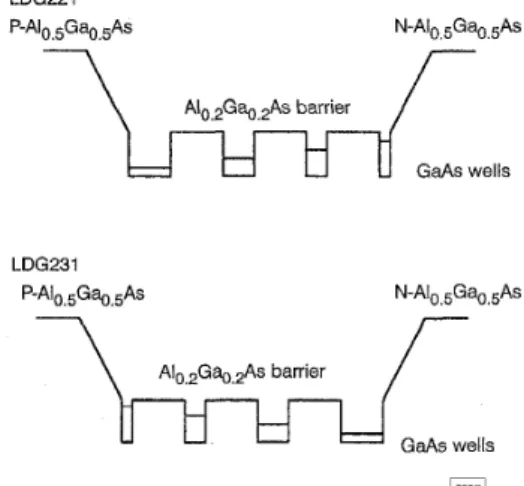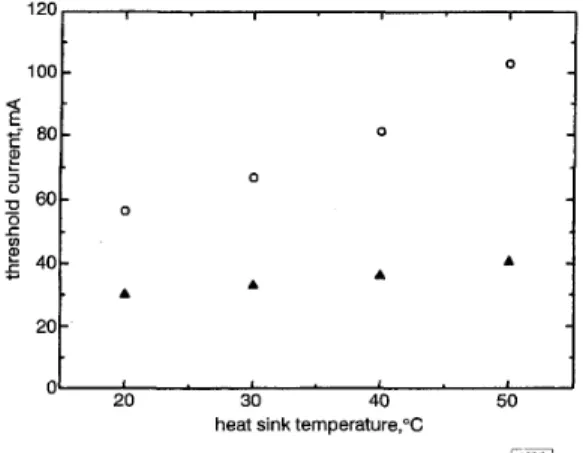References
BAUMANN, I., BOSSO, S., BRINKMANN, R., CORSINI, R. , DINAND, M., GREINER, A., SCHAFER, K., SOCHTIG, J., SOHLER, w., SUCHE, H., and WESSEL, R : ‘Er-doped integrated optical devices in LiNbO,’, IEEE J , Sel. Topics Quantum Electron., 1996, 2, (2), pp. 355-366
STRASSER, T.A., PEDRAZANNI, J.R., and MINFORD, w.: ‘Hybrid Q-
switched laser with Ti-indiffused LiNbO, and Er-Yb codoped glass waveguides’, IEEE Photonics Technol. Lett., 1997, 9, (12), pp. VEASEY, D.L., GARY, J.M., AMIN, J., and AUST, J.A.: ‘Time-dependent
modelling of erbium-doped waveguide lasers in lithium niobate pumped at 980 and 1480nm’, IEEE J. Quantum Electron., 1997,33, (IO), pp. 1647-1662
MICHELI, M., and OSTROWSKY, D B.: ‘Short pulse, high power Q-
switched Nd:MgO:LiNbO, waveguide laser’, Electron. Lett., 1993, 29, (2), pp. 175-176
B.4LSAM0, S., MAIO, S., MONTROSSET, I , SUCHE, H., and SOHLER, W :
‘Q-switched Ti:Er:LiNbO, waveguide laser’ (submitted for
publication)
YENIAY, A., DELAVAUX, J.-M.P., TOULOUSE, J., BARBIER, D.,
1580-1582
LALLIER, E., PAPILLON, D., POCHOLLE, J.P., PAPUCHON, M., DE
MOCVD. They are termed LDG221 and LDG231, and their sequences are shown in Fig. 1. The LDG23 1 sample has been used to fabricate superluminescent diodes which demonstrate that all four wells are able to contribute significant emission [SI. Standard processing techniques were used for the device fabrication. Fabry- Perot laser diodes with a 6 pn ridge waveguide were fabricated on the two types of substrate. No coatings were applied to the device facets. The measured devices are all 7OOp.m long.
al evidence of nonuniform carrier
in multiple-quantum-well laser
diodes
Bor-Lin Lee, Ching-Fuh Lin, Jie-Wei Lai and Wei Lin
Carrier distribution in multiple quantum wells is studied. Nonuniform carrier distribution is evidenced by the lasing characteristics of laser diodes with multiple quantum wells of
different widths. It is shown that the well sequence significantly influences the threshold current and the characteristic temperature owing to nonuniform carrier distribution.
Carrier distribution in multiple quantum wells (MQWs) is an important issue for understanding the static and dynamic behav- iour of QWs [l]. The carrier distribution over MQWs is highly nonuniform and has been studied theoretically [2, 31. In contrast, less experimental evidence has been presented [4]. In this Letter, we demonstrate the experimental evidence of nonuniform camer distribution by measuring the lasing characteristics of laser diodes fabricated on substrates with four quantum wells of different widths.
LDG221
p-A’0.5G%.5AS
/685/21
Fig. 2 Measured spectra of laser diodes
Fig. 2 shows the measured spectra of the fabricated Fabry-Perot laser diodes. The variation of the lasing wavelength with tempera- ture is also shown in Table 1. In spite of the different sequences of the four wells, they both oscillate at the wavelength around 870 nm, which corresponds to the emission energy of the 1258, well. Because emissions due to the narrow wells always have a larger energy than the separation energy of the first quantised states in the conduction and the valence bands of the widest well, they could be absorbed by the widest well. Consequently, the emission
of the widest well experiences the least loss and oscillation is most likely to occur at the corresponding transition wavelength.
Table 1: Variation of lasing wavelength with temperature
LDG221 LDG23 1 867.3 867.5 869.7 870.5 871.8 873.3 874.8 875.7
m
GaAs wells LDG231 p-A’0.5G%SAsm
GaAs wellspij
Fig. 1 Layer structures of four quantum wells of different widthsThe layer structures of the substrates with four quantum wells for the study are shown schematically in Fig. 1. The well widths are 20, 33, 56, and 125A, respectively. Their n = 1 transitions sep- arate for -5OmeV, which is large enough to distinguish the corre- sponding emission spectra. Therefore, the spectrum measurement can be used to identify which well contributes to the emission. Two different sequences of the four wells have been grown by
Although the emission wavelength is the same, the threshold currents of the laser diodes fabricated from the two samples are different. Those fabricated on the LDG221 substrate have a threshold current -3On4, whde those fabricated on the LDG231 substrate have a threshold current almost twice this. The reason for this is discussed briefly in the following. The threshold current of a laser diode is determined by its material gain, confinement factor, internal loss, and mirror loss. Because the two samples have the same separate confinement heterostructures and waveguide structures, their internal loss, mirror loss, and confine- ment factor are approximately the same. This indicates that the difference in threshold comes from the different material gain at
the same injection condition. The material gain depends on tem- perature, wellibarrier structure, and carrier density in the QW [6]. Therefore, we believe that the carrier distribution among the four wells is different for the two samples. Because the LDG221 sample has its l25A well closest to the p-cladding layer, it has more holes accumulated in this wide well than the LDG231 sample has at the same injection current. Conversely, the LDG231 sample has the 1258, well closest to the n-cladding layer, so it has more electrons accumulated in this well than does the LDG221 sample. The experimental measurements indicate that the distribution of holes is the dominant factor. As a result, with the same injected current, LDG221 devices have more gain for the wavelength corresponding to the 1258, well than do the LDG231 devices, leading to a signif- icantly reduced threshold current for the LDG221 devices.
The dominant role played by the holes is further evidenced by the measurement of the temperature dependence of the threshold current. The characteristic temperatures of LDG23 1 devices and LDG221 devices are 50 and 100K, respectively. As is clearly shown in Fig. 3, the LDG231 devices suffer a more serious tem- perature effect. As the temperature increases, the mean free path of unbounded carriers, especially the holes [4], is reduced. This means that the holes in the LDG231 sample have more difficulty in passing through other wells to reach the 125A well, leading to significantly decreased hole concentration in this well at the same injection current. Consequently, the material gain of this sample is significantly reduced owing to the temperature rise, and hence more temperature effect is experienced.
0
2ow
O 20 30 40 50heat sink temperature,%
Pig. 3 Measured threshold current against temperature
0 LDG231
A
LDG221In conclusion, the lasing characteristics of semiconductor lasers are experimentally found to depend on the sequence of multiple quantum wells with different widths. The threshold current of laser diodes with the widest well closest to the p-cladding layer is only half that of laser diodes with the opposite well sequence. In addition, the former devices have a characteristic temperature twice that of the latter devices. These observations indicate that carrier distribution among the multiple quantum wells is not uni- form and that hole distribution plays the dominant role in deter- mining lasing characteristics.
0 IEE 1998
Electronics Letters Online No: 19980838
Bor-Lin Lee, Ching-Fuh Lin and Jie-Wei Lai (Institute of Electro- Optical Engineering and Department of Electrical Engineering, National Taiwan University, Taipei, Taiwan, Republic of China)
Wei Lin (Chung-Hwa Telecom Co. Ltd., Chugli, Taiwan, Republic of China)
30 April 1998
References
1 NAGARAJAN, R., FUKUSHIMA, T., CORZINE, S.W., and BOWERS, J.E.:
'Effects of carrier transport on high speed quantum well lasers',
Appl. Phys. Lett., 1991, 59, pp. 1835-1837
2 HANGLEITER, A., GRABMAIER, A., and FUCHS, G : 'Damping of the relaxation resonance in multiple-quamtum-well lasers by slow interwell transport', Appl. Phys. Lett., 1993, 62, pp. 2316-2318
3 TESSLER, N., and EISENSTEIN, G.: 'On carrier injection and gain dynamics in quantum well lasers', ZEEE J. Quantum Electron.,
1993, 29, pp. 1586-1595
4 YAMAZAKI, H., TOMITA, A., and YAMAGUCHI, M.: 'Evidence of
nonuniform carrier distribution in multiple quantum well lasers',
LIN, CHING-FUH, and LEE, BOR-LIN: 'Extremely broadband ALGaAs/
GaAs superluminescent diodes', Appl. Phys. Lett., 1997, 71, pp. 1598-1600
ASADA, M., KAMEY, A., and SUEMATSU, Y.: 'Gain and intervalence
band absorption in quamtum-well lasers', IEEE J. Quantum Electron., 1984, 20, pp. 745-753
Appl. Phys. Lett., 1991, 71, pp. 161-169 5
6
High-temperature operation of 1.3pm
AlGalnAs strained multiple quantum well
lasers
K.
Takemasa,T.
Munakata, M. Kobavashi,H. Wada
and T
KamijohHigh-temperature operation of 1 . 3 ~ AIGaInAs/InP strained multiple quantum well lasers is demonstrated. An excellent CW characteristic temperature of 11 1 K was obtained between 20 and 80°C and a record high operating temperature of 210°C was achieved with a 7 0 0 ~ long laser under pulse excitation. Power reductions at a constant current with increasing temperature were also evaluated at 80°C to be -1.27 and -1.67dB under pulse and
CW excitations, respectively.
Introduction; 1.3 pm semiconductor lasers are important light sources for application to subscriber loop networks and optical interconnection systems and are required to operate over a wide temperature range without thermoelectric devices. To achieve this, electron overflow from active layers must be suppressed at high temperatures. AlGaInAsAnP systems, which have a larger conduc- tion band offset
(AE?
= 0.72 AEJ than conventional GaInAsPiInP systems (AEc = 0.4Ai?,),
have been proposed to reduce the elec- tron overflow [ 11, and excellent temperature characteristics of AIGaInAsLnP lasers have been demonstrated [2, 31. Recently, we have reported AlGaInAsiInP lasers with p-AlInAs electron stop- per layers (ESLs) introduced between the multiple quantum well (MQW) active and p-type separate confinement heterostructure (SCH) layers to further suppress electron overflow from MQW to SCH layers [4]. The characteristic temperatures of threshold cur- rent and slope efficiency were found to be improved by ESLs. The improvement was more remarkable at higher temperatures and the maximum operating temperature of lasers with ESL was found to be higher than that of lasers without ESL.b temperature,%
pzJ
Fig. 1 Temperature dependence of threshold current and slope effi-
ciency for lasers with various cavity lengths under CW excitation a Threshold current
b Slope efficiency (i) (ii) L L = = 3 5 0 p 2 0 0 p
(iii) L = 7 0 0 ~
CW, 28-95%
In this Letter, we report the high-temperature characteristics of
1 . 3 ~ AlGaInAsLnP strained MQW lasers with the p-AlInAs ESL. Excellent characteristic temperatures of 11 1 K between 20 and 80°C and 90K between 80 and 110°C were achieved. CW laser operation was obtained up to 170°C and a record high oper- ating temperature of 210°C was achieved under pulse excitation. ELECTRONICS LETTERS 11th June 1998 Vol.

